
Andrey Pospelov, Candidate of Historical Sciences, Associate Professor of Odesa Mechnikov National University, Full Member (Academician) of the International Academy of Life Safety
Weapons and Military Equipment for the Army of the Armed Forces of Ukraine. Part 3
Artillery and Missile Equipment
|
|
In modern warfare, where the strategists and tacticians more and more rely on remote striking of the enemy, the role and importance of various artillery and missile systems, both managed and unmanaged, is constantly increasing. The Anti-Terrorist Operation (ATO) in Donetsk and Luhansk regions confirms this.
In the system of the Soviet military-industrial complex, missile and artillery companies of the Ukrainian Soviet Socialist Republic (USSR) had a specific role. On the one hand, there was a most powerful in the world missile company — Pivdennyi (Southern) Machine-Building Plant in Dnepropetrovsk and the Special Design Bureau number 585 named after M. Yangel (now CB “Yuzhnoye” (“Southern”). This unique scientific-industrial complex was actually a brilliant in the Soviet strategic sphere, since it was there that were developed and produced the most powerful and effective Soviet intercontinental ballistic missiles MR-UR-100, P-36M (R-36UTTKh), RT-23 and carrier rockets on their basis — “Zenit”, “Dnepr” and so on. These products were especially appreciated by officers of the Soviet Strategic Missile Forces, as the well known saying went: “Korolyov is working for TASS, Chelomey — for the toilet, but Yangel — exclusively for us”.
On the other hand, in terms of tactical missile equipment, the USSR was only a producer, although quite an important one. This refers primarily to the well-known Kiev Plant named after Artem (now the State Enterprise “Artem”), where various antitank, air-to-air and light (for MANPADS) missiles were made, as well as a number of other businesses. Meanwhile, artillery systems in the Soviet Ukraine had not been actually developed, although in May 1986 at the famous Kiev plant “Bolshevik” was created a special design bureau — KB-86 of the Ministry of Defence of the USSR [1]. Since the infrastructure of artillery KBs and enterprises in the USSR was quite developed and located mainly in Russia, it is difficult to explain the reasons for the foundation of the KB-86 at that time. It is possible that this was purely a political decision of the then First Secretary of the Communist Party of Ukraine V. Scherbytskyi, trying to turn the USSR into the most developed Soviet Republic.
Ukraine's having become independent effected its defense enterprises. Dnepropetrovsk “Pivdenmash” virtually ceased production of combat intercontinental missiles, concentrating on the production of civilian goods and space launch vehicles. Most of the company's products was destined for the Russian Federation, especially after Ukraine in 1996, had given up nuclear weapons. The same can be said of the company “Artem”. Although it had been producing the most advanced tactical missiles, but without Russian components and development it could not do for some time.
However, at the dawn of Ukrainian independence our governors and experts-designers were sure that Ukrainian defense enterprises should go to the domestic and foreign market with their own products. Especially because design developments of Ukrainian specialists in Soviet times were quite iconic, even though most of them were created in the initiative order.
Because of this, from 1992 to about 2005, a number of existing enterprises of the Ukrainian military-industrial complex (MIC) were transformed. They got a new status. For example, on the basis of CB-86 (later — the State Scientific and Technical Center for artillery and small arms) was created the State Enterprise “Design Bureau “Artillery Equipment” (SE “KBAO”), which, in fact, became the center of the development of Ukrainian artillery and mortar systems. Kyiv Design Bureau “Luch” (since 1965 — the main developer in the USSR of automated monitoring and diagnosing of special aircraft equipment), since 1992 is gradually turning into a major Ukrainian developer of tactical missile systems [2], and the plant “Artem” is the main maker of products of “Luch”.
 |
| Antitank guided missile “Barrier-V” http://bm-oplot.livejournal.com/ |
Already the first Ukrainian missile developments — antitank systems “Skif” (together with Belarus), “Barrier” and “Barrier-V” — were widely recognized outside Ukraine (thanks to the newest and most importantly, secure systems of control and destruction of targets). These complexes were exported not only to CIS countries (Azerbaijan, where they were first tested in combat, Georgia, Turkmenistan, and so on), but also to Israel and PRC.
By the beginning of the second decade of the 21st century, Ukrainian missile manufacturing was ready to provide the Armed Forces (AF) of Ukraine and export contracts with various ATGM, our own MANPADS, “air-to-air” short-range guided missiles and aerial bombs. By their characteristics, these systems were at the level of the best world standards and by the “cost-effectiveness” criteria they were significantly better than samples of western (by cost) and Russian (by efficiency) make. This provided them with a specific export success and relatively rapid adoption by the Ukrainian Armed Forces. However, like in other kinds of weapons of our own production, the number of complexes purchased by the Ministry of Defense of Ukraine was little.
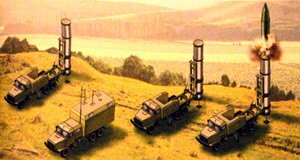 |
| Battery of operational-tactical-missile complex “Sapsan” http://militaryrussia.ru/ |
Meanwhile, from the beginning of its existence, the Ukrainian Armed Forces needed longer-range systems too. That is why since 1994 the KB “Yuzhnoye” has been developing the multifunctional operational-tactical missile complex “Sapsan”. It was to become the first purely Ukrainian ballistic missile. However, due to some technical and subjective reasons, until 2013 not much progress in the creation of the complex was observed, if not to take into account the spent more than 200 million hryvnyas. That is why in June 2013 the Ministry of Defense of Ukraine abandoned further development of the project “Sapsan” [3], because, if nothing else, a similar complex was prepared by the firm “Luch” [4]. However, the complex developed by Kyivites has not been adopted into service either.
However, the KB “Yuzhnoye” has already had a counterpart — a cruise missile “Korshun” of both types, aviation and sea-basing. It was created by the renowned Soviet strategic cruise missile Kh-55 (RKV-500) [5]. However, despite the uniqueness of the scheme and project completion, this operational and tactical weapon has not been taken into service by the leadership of Ukrainian Armed Forces. The reason lies perhaps in fear of the leaders of the state to come under criticism of western partners who are ready to accuse them of violating the Treaty on the Elimination of Intermediate and Shorter-range Missiles of December 1987, as both, “Sapsan” and “Korshun” are theoretically designed for the range of 280 km but their design allows to make missiles with the range of over 500 miles (almost 3.000 km).
|
|
Today we can only regret that the Ukrainian government is so passive in promoting programs of guided operational-tactical missiles. Their presence in the Ukrainian Armed Forces would constrain potential aggressors by the very fact of their existence (especially in the situation where the real firing range would be unknown to them). Moreover, both complexes would have considerable export potential, especially in today's conditions, when actual exporters of missiles with the range of over 100 km are Iran, China and North Korea, and the potential exporter is Russia. All these countries, for a number of political reasons, first of all related to their position in the world, have to secretly sell these weapons to potential customers (North Korea), or send them only to their strategic ally (China — to Saudi Arabia, Iran — to Syria). Or just to abandon contracts (like it was in 2012, when the Russian Federation was unable to sell Syria its operational-tactical missiles “Iskander”). Ukraine, having very effective and cheap weapons, being in an advantageous international position, could actively promote at the markets of Asia, Africa and Latin America, its ballistic and cruise operational-tactical missiles, getting a large inflow of foreign currency and consolidating its status as a unique exporter.
Unlike missile equipment, the situation with artillery systems during the first years of Ukrainian independence looked quite different. Firstly, the guns, howitzers and mortars of Soviet make that were in-service in the Armed Forces, were more than enough for securing the defense of Ukraine. Secondly, state warehouses were filled with shells and mines of all calibers. Thirdly, theoretically the scientific and engineering potential was not enough to create completely new artillery systems. However, everything was changed in 1996 by the contract for the supply to Pakistan of 320 main battle tanks T-84 of Ukrainian make.
The weakest link of the contract between Ukraine and Pakistan was tank guns 2A46 (D-81TM), made in Russia at the association “Motovilikhinskiye Zavody”. Hoping that without guns Kharkiv Plant named after V. Malyshev would not be able to fulfill export orders, Moscow officially refused to sell those weapons to Kyiv. And although the Kharkiv plant produced T-84 with the rate of 100-110 tanks during the year, to fulfill the contract without radical solutions was impossible.
But Ukrainian experts did find the way out. The first 145 tanks were going to Pakistan with towers, removed from Ukrainian T-80UD tanks. However, there were no more than 310 such tanks (tank-sets) in the Ukrainian Armed Forces. So, in case of continuation of this “cannibalization”, execution of the contract in its entirety was not possible. Moreover, Ukraine was actively advertising its first tank, and potential orders for it could be more impressive. Therefore, the need to equip Ukrainian tanks with guns of domestic development and production had become an extremely urgent task.
And Ukraine did manage to create a 125-mm tank gun, and at this, in a very short time, thanks to the joint work of the security forces, economic agencies and Ukrainian designers of the recently established State Scientific and Technical Center for artillery and small arms (later — Kyiv Design Bureau “Artillery Equipment”). Trying to get out of the situation artificially created by Russia, Ukrainian specialists partly copied the 2A46 from the Western German 120-mm gun Rh-120, the basis of weapons of the famous German tank “Leopard-2A”. The relevant information FRG was giving to Spain in order to organize licensed production of “leopards” at enterprises of the latter (contract of 1995). However, Spanish “Leopard-2A5” have never turned up [6].
The combination of design features of the Soviet 2A46 and Western Germany's Rh-120 led to the creation of a purely Ukrainian 125-mm tank gun KBA-3 (or KBA3). By its combat characteristics it surpassed Russian modifications of the famous Soviet system. Moreover, specifically for fulfillment of prospective export orders, Kharkiv Machine Building Design Bureau (KMDB) named after O. Morozov created a 120-mm tank gun KBM-2 which in all respects (except for efficiency of use of shaped charge projectiles) proved better than the well-known Rh-120 and its American and Israeli counterparts.
 |
| Ukrainian 125-mm tank gun KBA-3 http://www.morozov.com.ua/ |
Barrels of tank guns were made at Sumy plant named after Frunze where in Soviet times was produced equipment for the oil and gas complex. The guns themselves were fully assembled at the Kharkiv Malyshev plant. Thus, Moscow's active and quite “clumsy” policy ended in the creation in Ukraine of the entirely new industry — development and production of modern tank guns.
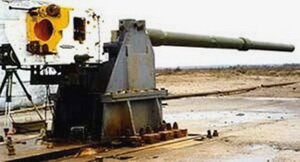 |
| Prospective Ukrainian 140-mm tank gun 55L “Bagira” http://raigap.livejournal.com/ |
At this, the new industry of the Ukrainian MIC, despite its young age (like that of the tank production in Ukraine in general), has turned out to be quite promising and creative in the directions of its development. This is confirmed by the development of the 55L tank gun “Bagira” for the promising 140-mm caliber. And while in the West and in Russia guns of such caliber have been only talked about, in Ukraine this gun is already being tested, and by the beginning of 2013 it had actually been brought to the stage of the installation, both on prospective and existing main battle tanks. Mainly due to the fact that the new gun breech is made in sizes of existing caliber 120-mm and 125-mm. That is, from the practical and export points of view, the new Ukrainian tank gun is better than similar caliber systems which are now being developed in other leading “tank” countries [7].
Besides, for tank guns Kyiv Design Bureau “Luch” has created an armored ATGM “Combat” with a very unique, almost absolutely protected from exposure to noise, control system and the ability to shoot down a helicopter (no other country in the world has such systems in service).
 |
| List of Ukrainian guided anti-tank missiles, which are launched from tank gun barrels http://bm-oplot.livejournal.com/ |
The success in the development of classic tank guns has not just brought Ukrainian tanks to the forefront in the world, but has also fueled the ambitions of Ukrainian designers and manufacturers. They headed for creation of other artillery systems, primarily for the modernization of Soviet armored vehicles samples.
The SE “KBAO” together with the Science and Technology Company “Precision Mechanic Plant” in Kamyanets-Podilskyi makes 30-mm automatic guns ZTM-1 (KBA-2) and ZTM-2, which by its characteristics (due to the scheme of the recoil of the barrel) has surpassed the Soviet 2A42, where automatic had been working due to powder gases. This allowed to more radically upgrade warheads of light armored vehicles, thereby to drastically reduce the internal gas pollution of combat vehicles. However, a more radical scheme for improvement were the remote weapon stations (combat modules) proposed by Ukrainian experts.
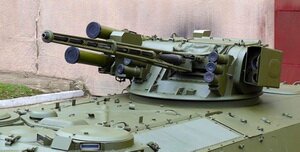 |
|
Combat module BM-5 “Shtil-S” |
Strange as it might seem, but in this matter Ukraine has become perhaps the most advanced country in the world. At least three companies: SE “KBAO”, Kharkiv Morozov Design Bureau and Mykolayiv Mechanical Repair Plant have offered a number of such systems — KBA.105 “Shkval”, BAU-23x2, “Grom”, “Parus”, and so on. All these systems, except the automatic guns, were equipped with machine guns, automatic grenade launchers, anti-tank missile systems and smoke mortars. On them can be mounted anti-aircraft missiles and other weapons systems. These combat modules are truly universal as they can be mounted not only on all sorts of ground equipment (and not necessarily on armored one), but also on boats and small ships. The latter actually takes the shipbuilding industry of the Ukrainian MIC to a completely different level.
As of 2014 the weak link in the Ukrainian production of artillery remains the development and production of classical systems of field artillery. Despite the fact that the SE “KBAO” has developed 60-mm, 82-mm infantry mortars and 152-mm trailer-mounted howitzer [8], and the corporation “TASKO” — a self-propelled 152 (155-mm) gun on the basis of “KrAZ-6316“ these systems have not been adopted into service yet. However, the current ATO in the East of the country, most likely in the nearest future, will raise the question of the need to equip the Armed Forces of Ukraine with our own artillery systems.
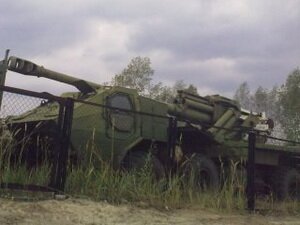 |
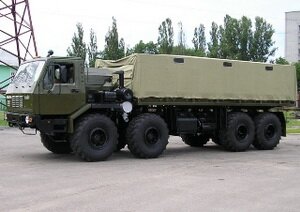 |
|
152-mm self-propelled artillery “MSTA-K”. KrAZ-6316 http://alternathistory.org.ua/ |
|
- http://kba.kiev.ua/o_predprijatii.html
- http://www.luch.kiev.ua/index.php/ru/pro-predpriyatie/istoriya
- Ministry of Defence will abandon the program of the missile complex “Sapsan” // http://www.ukrinform.ua/rus/news/ministerstvo_oboroni_otkagetsya_ot_programmi_raketnogo_kompleksa_sapsan_1532685
- Ukrainian army has found a replacement for “Sapsan” // http://vlasti.net/news/173160
- A draft of a cruise missile “Korshun” (Ukraine) // http://raigap.livejournal.com/297981.html
- http://tanky.dovidnyk.info/index.php/tanki_poslevoennogo_perioda/105/190
- http://raigap.livejournal.com/190343.html
- http://kba.kiev.ua/buksiruema_gaubicja_152_mm.html

